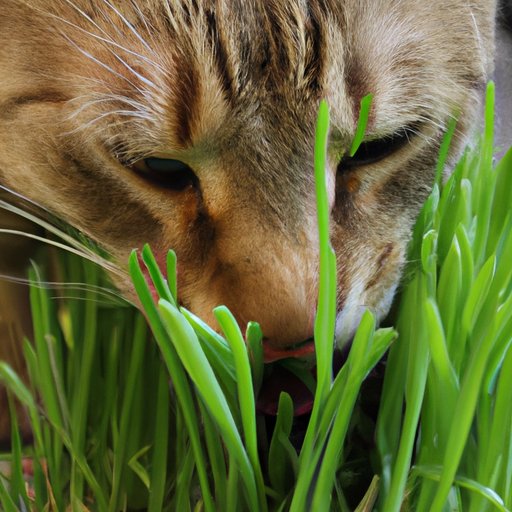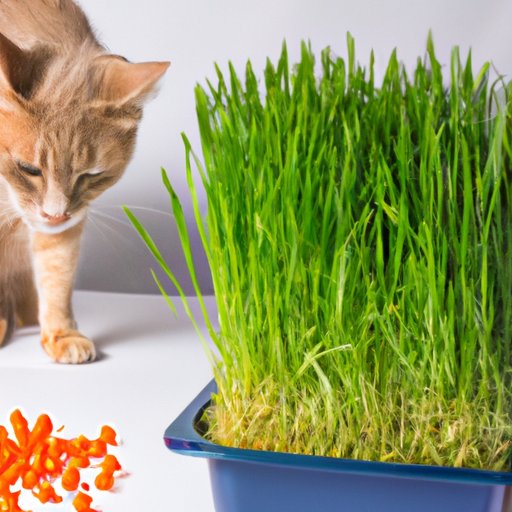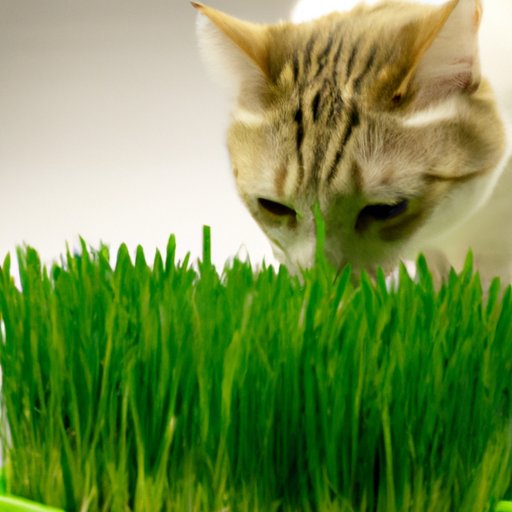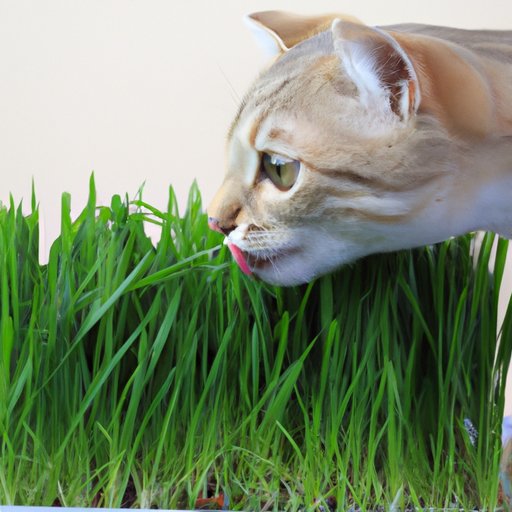Introduction
Cats have a tendency to eat unusual things, from houseplants to grass. If you’ve noticed that your indoor cat has taken a liking to the latter, you might be wondering if it’s actually beneficial for them to do so. Eating grass is actually quite common in cats and may even provide some nutritional benefits. In this article, we’ll explore the potential benefits and risks associated with feeding grass to an indoor cat so that you can make an informed decision about whether or not it’s a good option for your pet.

Exploring the Benefits of Feeding Grass to Indoor Cats
There are several potential benefits of feeding grass to indoor cats. Let’s take a closer look at each one.
Nutritional Benefits
Grass contains vitamins, minerals, and other nutrients that can help keep your cat healthy. Additionally, some cats may enjoy the taste of grass and may even find it more palatable than their regular food. This can be especially helpful if you’re having trouble getting your cat to eat a balanced diet.
Mental Stimulation
Eating grass can also provide mental stimulation for your cat. Foraging for grass is an instinctive behavior in cats and can be a great way for them to exercise their minds. Additionally, it can help relieve boredom and provide an outlet for their natural curiosity.
Natural Instincts
As previously mentioned, eating grass is a natural behavior in cats. This is because grass is an important source of fiber in the wild and can help cats digest their food more effectively. Additionally, some cats may eat grass as a way to induce vomiting if they’ve eaten something that doesn’t agree with them.
The Pros and Cons of Feeding Grass to Indoor Cats
Now that we’ve explored the potential benefits of feeding grass to indoor cats, let’s take a look at the pros and cons of doing so.
Pros
Feeding grass to your indoor cat can provide several benefits. As previously mentioned, it can provide valuable nutrients and mental stimulation. Additionally, it can help satisfy their natural instincts and provide a safer alternative to outdoor plants, which may contain toxins or parasites.
Cons
However, there are also some potential drawbacks to feeding grass to your indoor cat. For instance, some cats may be allergic to certain types of grass, which can cause uncomfortable side effects. Additionally, if your cat consumes too much grass, it can lead to digestive issues such as vomiting or diarrhea. It’s important to monitor your cat closely when introducing them to grass and to consult with your veterinarian if you have any concerns.

Tips for Feeding Grass to an Indoor Cat
If you decide to feed grass to your indoor cat, there are a few things you should keep in mind. Let’s take a look at some tips for ensuring that your cat gets the most out of the experience.
Types of Grass
Not all grasses are created equal. Some types of grass can be toxic to cats, so it’s important to research the type of grass you plan to feed your cat. It’s best to stick to grasses that are specifically marketed as being safe for cats. You should also avoid giving your cat grass that has been treated with pesticides or herbicides.
Safety Precautions
It’s also important to take safety precautions when feeding your cat grass. Make sure to always supervise your cat when they’re eating grass and remove any uneaten grass after they’re done. Additionally, make sure to wash your hands after handling the grass to avoid transferring any bacteria or parasites to your cat.
Alternatives
If you’d prefer not to feed your cat grass, there are plenty of other options available. You can purchase cat grass kits that are specifically designed for indoor cats, or you can grow your own cat grass at home. You can also try adding vegetables such as spinach or kale to your cat’s diet to provide them with the same nutritional benefits.
Is Eating Grass Healthy for Indoor Cats?
Overall, eating grass can be a healthy and beneficial activity for indoor cats. However, it’s important to remember that every cat is different and that some cats may not tolerate grass well. Additionally, it’s important to take safety precautions when feeding your cat grass to avoid any potential risks.

A Closer Look at the Nutritional Benefits of Grass for Indoor Cats
Now that we’ve explored the potential benefits and risks of feeding grass to an indoor cat, let’s take a closer look at the nutritional benefits of grass for indoor cats.
Vitamins and Minerals
Grass is a rich source of vitamins and minerals, including vitamin A, vitamin C, and calcium. These nutrients can help support your cat’s immune system and keep them healthy overall.
Fiber
Grass is also a good source of fiber, which can help keep your cat’s digestive system running smoothly. Fiber can also help cats feel fuller for longer, which can be helpful if you’re trying to manage your pet’s weight.
Antioxidants
Finally, grass is a good source of antioxidants, which can help protect your cat’s cells from damage caused by free radicals. Antioxidants can also help reduce inflammation and support your cat’s overall health.
Conclusion
In conclusion, feeding grass to an indoor cat can provide a variety of benefits. It can provide valuable nutrients, mental stimulation, and an outlet for their natural foraging instincts. However, it’s important to take safety precautions when feeding your cat grass and to consult with your veterinarian if you have any concerns. Ultimately, the decision to feed your cat grass is up to you, but it’s important to consider all of the potential benefits and risks before making a decision.
Summary
Feeding grass to an indoor cat can provide valuable vitamins, minerals, and other nutrients and can help satisfy their natural instincts. However, it’s important to consider the potential risks and to take safety precautions when feeding your cat grass. Ultimately, the decision to feed your cat grass is up to you, but it’s important to do your research before making a decision.
Final Thoughts
Feeding grass to an indoor cat can be a healthy and beneficial activity, as long as you take the proper precautions. Be sure to research the types of grass that are safe for cats and to always supervise your pet when they’re eating. Additionally, make sure to consult with your veterinarian if you have any concerns.
(Note: Is this article not meeting your expectations? Do you have knowledge or insights to share? Unlock new opportunities and expand your reach by joining our authors team. Click Registration to join us and share your expertise with our readers.)
